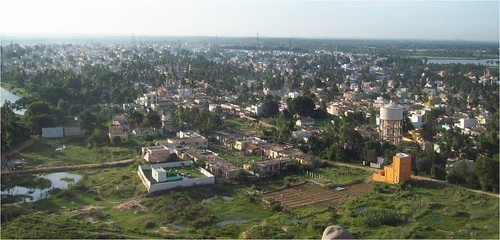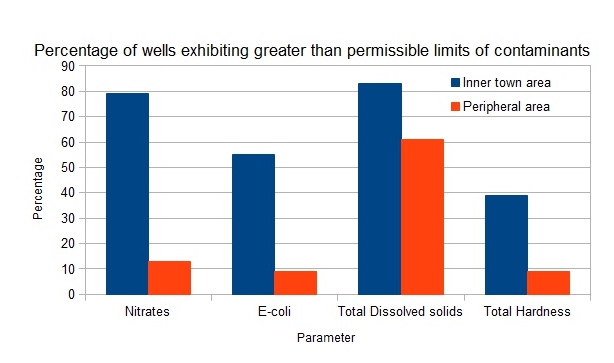Given the many problems associated with flush toilets and the sewerage system, pit toilets offer a viable solution in India. However, the use of soakpits raises the question of groundwater contamination. This paper assesses the impact of pit toilet leachate on groundwater quality in Mulbagal town (pop ~ 60,000) in Karnataka relies on pit toilets, and uses groundwater for drinking. Methodology:
Methodology:
The study examined water samples from 69 wells, of which 43 were located within the town, and the remainder in the periphery. Details of sample collection and laboratory analysis are presented in the paper.
Results:
The figure below illustrates that more inner wells were contaminated than the peripheral wells. In addition, the extent of contamination also mirrored this, with the average values of contamination for the inner wells being much more than that for the peripheral wells. 
Analysis indicates that 'rock weathering mechanism controls the chemistry of groundwater outside the town (PHS samples), while, evaporation-crystallization controls the chemistry of groundwater inside the town (ITS samples)'.
The study also looks at the efficacy of the vadose zone in the removal of pollutants. The vadose zone is the soil layer between the land surface and the top of the water level. It found that wells with water table depths of 25m or greater are free from E-coli contamination.
Conclusions:
The higher levels of contamination in wells inside the town and data analysis prove that leachate infiltration from pit toilets is the primary source of contaminants. On the other hand, rock weathering is the primary source in areas outside the town. The paper also proved that the vadose zone facilitates removal of Ecoli and of nitrates.
Previously published in the Environmental and Earth Science Journal, DOI 10.1007/s12665-012-1794-9





 impact_pit_toilet_leachate_groundwater_chemistry_mulbagal.pdf
impact_pit_toilet_leachate_groundwater_chemistry_mulbagal.pdf







